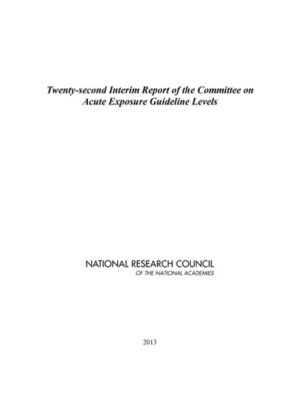Twenty-second Interim Report of the Committee on Acute Exposure Guideline Levels
ebook
By National Research Council

Sign up to save your library
With an OverDrive account, you can save your favorite libraries for at-a-glance information about availability. Find out more about OverDrive accounts.
Find this title in Libby, the library reading app by OverDrive.



Search for a digital library with this title
Title found at these libraries:
| Library Name | Distance |
|---|---|
| Loading... |
In 1991, the Environmental Protection Agency (EPA) and the Agency for Toxic Substances and Disease Registry (ATSDR) asked the National Research Council (NRC) to provide technical guidance for establishing community emergency exposure levels for extremely hazardous substances (EHSs) pursuant to the Superfund Amendments and Reauthorization Act of 1986. As a result the NRC published Guidelines for Developing Community Emergency Exposure Levels for Hazardous Substances in 1993 and Standing Operating Procedures for Developing Acute Exposure Guideline Levels for Hazardous Substances in 2001; providing updated procedures, methods, and other guidelines used by the National Advisory Committee (NAC) on Acute Exposure Guideline Levels (AEGLs) for hazardous substances for assessing acute adverse health effects. Stemming from this report the NAC has developed AEGLs for at least 270 EHSs.
There are currently three AEGLs: AEGL-1, AEGL-2, and AEGL-3. AEGL-1 is the airborne concentration of a substance above which it is predicted that the general population could experience notable discomfort, irritation, or certain asymptomatic nonsensory effects. These effects are not disabling and are transient and reversible once exposure is stopped. AEGL-2 is the airborne concentration (of a substance above which it is predicted that the general population could experience irreversible, long-lasting adverse health effects or an impaired ability to escape. AEGL-3 is the airborne concentration of a substance above which it is predicted that the general population could experience life threatening health effects or death.
On April 22-24 2013, the NRC-established Committee on Acute Exposure Guideline Levels 2013 met to review AEGL documents approved by the NAC. The committee members were selected for their expertise in toxicology, medicine, industrial hygiene, biostatistics, and risk assessment. Twenty-second Interim Report of the Committee on Acute Exposure Guideline Levels presents a review of AEGLs for various chemicals including acrylonitrile, halogen fluorides, tellurium hexafluoride, and thionyl chloride.







